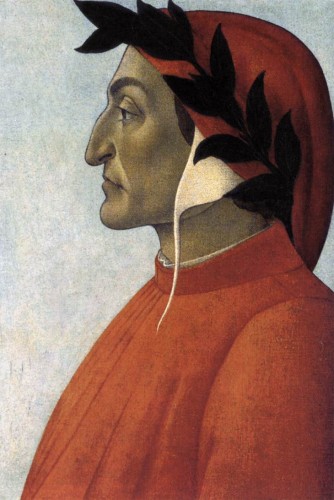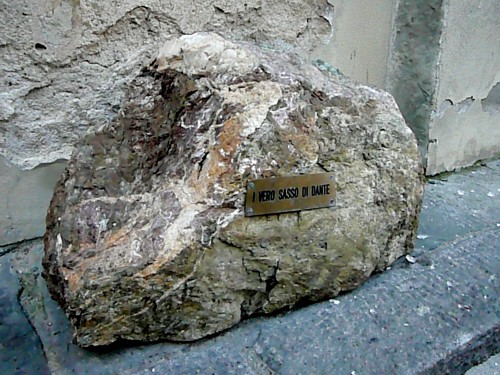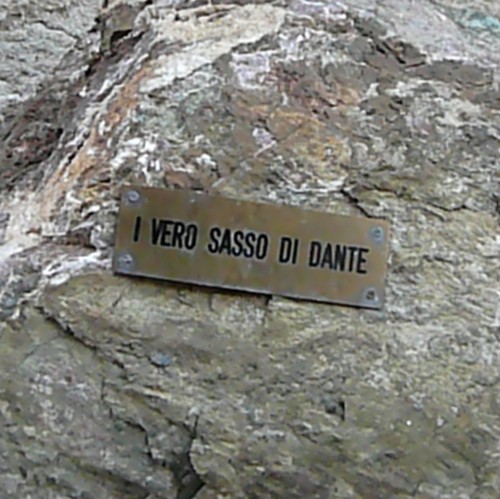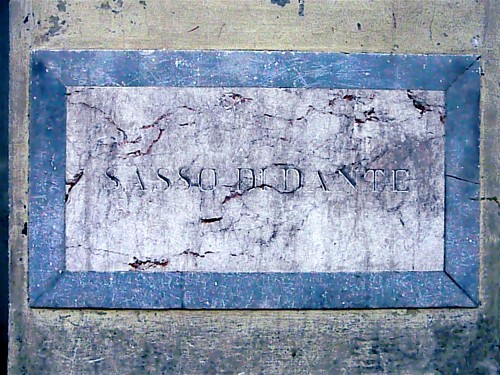I had been looking for Dante’s Stone for years. Not every day mind you, but off and on … for years. The story of the Sasso di Dante has been talked about for centuries. Seven centuries to be exact, because the last time Dante could have sat on his rock was 1302; that year he was banished from Florence, never to return.

Guidebooks told me that the stone was gone. No big surprise. But it was repeatedly reported that a plaque had been placed on a wall where the rock sat and where Dante sat on the rock. It was supposed to be on the wall in Piazza delle Pallottole. I looked on every wall in the tiny piazza. I couldn’t find the plaque.
From the stories that have filtered down through the ages, you would think that Dante never did anything, but jot poems. The Sasso di Dante supports this idea. Dante reportedly relaxed on this stone a lot, either (depending on the source you are reading):
1) watching the cathedral walls go up (the Duomo’s dome wouldn’t go on for another 150 years),
2) catching the cooling wind on summer days (it’s true, it’s one of the few places in town where the air moves in the summertime);
3) writing love poems (first poem at age 18 (1283); then between 1290 and 1293, he wrote Vita Nuova, a book of prose and poetry about his love for Beatrice), or
4) talking politics (Dante entered city government in 1295).
But Dante was not always hanging out in Piazza delle Pallottole. He rode a horse into two, maybe three, major battles, managed the family estates, and as mentioned before, served as a political appointee.
No reference book says Dante was watching games of bocce ball from his sasso, but Piazza delle Pallottole is so named because it was a piazza where the game of pallottole, a type of bocce ball game, was permitted to be played.
Today, there is an old trattoria called, not surprisingly, Sasso di Dante, that takes up most of the piazza.

But back to the search for the plaque. One day, about two years ago I was taking a shortcut through the alley alongside the trattoria in Piazza delle Pallottole and there against the opposite wall, blocking a narrow sidewalk, was a huge stone with a metal tag that read “I Vero Sasso di Dante” (incorrect Italian (missing an apostrophe) for The True Stone of Dante). I swear on all three parts of the Divine Comedy it had not been there the month before.
Now I could bring my touring clients to the spot and tell them the most famous story about the Sasso di Dante. It goes like this:
“Tradition says that an unknown person once accosted Dante seated in his favorite place and asked: ‘What do you like best to eat?’ Dante answered “A hard-boiled egg.” A year after the same man, whom Dante had not seen in the meantime, approached and simply asked: “With what?” Dante immediately replied: “With salt.”

In the late 1800s, the poet Carlo Gabrielli, set Dante’s egg story in rhyme (ottava rima) and ended with the moral: L’acuto ingegno apporta gloria; / Maggior, se v’é congiunta alta memoria.
I’m not sure this is a tale of great memory or a savant’s selective focus. Dante was reportedly a peculiar guy.
And by the way, I found the plaque. It’s very large, made of marble, and not in Piazza delle Palottole. It’s around the corner, in Piazza del Duomo, low on the side of a store that sells all things sacred (during this season – many crèches) and Catholic. I went in to ask when the marble sign was placed. “Twenty years ago or more.” I had been walking past for more than ten years without noticing – easy to do in Florence where the past comes to greet even the longtime visitor every day.

